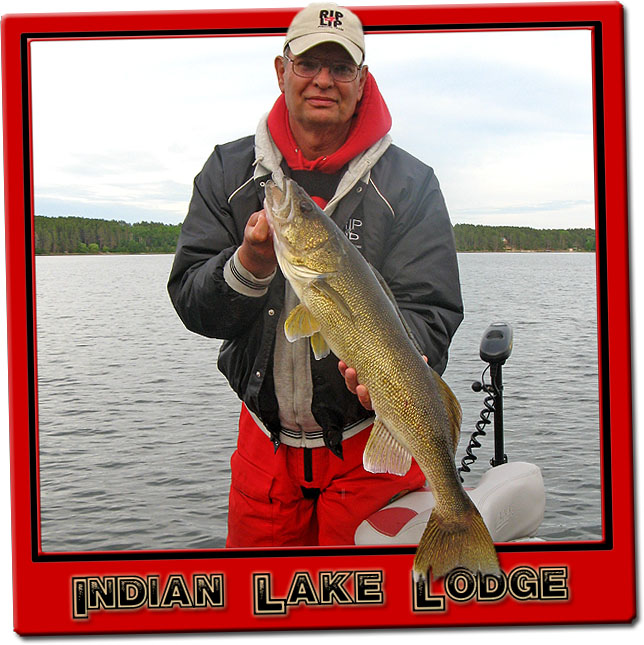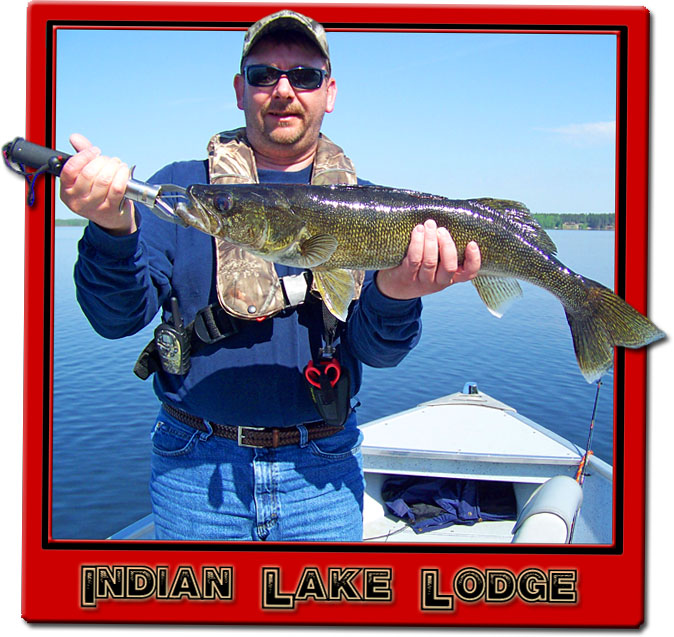Ontario Walleye Fishing on Indian Lake
 The Chain offers one of the finest walleye fisheries in the north, it is stuffed full with walleye of all sizes. It consists of 9 connecting lakes with countless open water bays, narrow channels and structure to provide endless opportunity to find a great walleye fishing spot to call your own. The Indian Chain is relatively shallow and the "tea coloured" water provides excellent walleye fishing opportunities throughout the day. Guests have little trouble catching their meal of walleye, day in and day out. The abundant numbers of walleye caught are on average 2 - 4 lbs. It's not rare to hook lots of fish over 5 lbs. We have seen several live released fish between 10 &13 lbs. Our guests are proud to actively promote catch and release, keeping our good spawner's to ensure that Indian Lake Chain is productive for years to come! We take pride in our guests catching large fish and releasing them to grow even larger.
The Chain offers one of the finest walleye fisheries in the north, it is stuffed full with walleye of all sizes. It consists of 9 connecting lakes with countless open water bays, narrow channels and structure to provide endless opportunity to find a great walleye fishing spot to call your own. The Indian Chain is relatively shallow and the "tea coloured" water provides excellent walleye fishing opportunities throughout the day. Guests have little trouble catching their meal of walleye, day in and day out. The abundant numbers of walleye caught are on average 2 - 4 lbs. It's not rare to hook lots of fish over 5 lbs. We have seen several live released fish between 10 &13 lbs. Our guests are proud to actively promote catch and release, keeping our good spawner's to ensure that Indian Lake Chain is productive for years to come! We take pride in our guests catching large fish and releasing them to grow even larger.
The walleye are active when using crank baits and spinner baits while trolling most shore lines. Once you find the school of them, jigging or lindy rigging with Minnow's, crawlers and leaches are all productive baits. A medium to light rod with 6 to 8 lb test is best suited for walleye fishing. In general a north west wind will give you the best fishing for walleye.
It's not just a myth!
Wind from the east, fish bite the least.
Wind from the west, fishing bite the best.
Spring fishing for walleye: (Middle of May up until the end of June)
You will find the walleye shallow and scattered along all banks. The walleye are most aggressive after the spring spawn. Jigging, spinner baits and shallow rapala's are productive baits during this time. White, orange, blue, silver and chartruce are popular colours to throw. Stay within 4 to 10 feet of water along all shore banks where there is visual rocks and trees for structure and you are sure to have a productive day.
Summer fishing for walleye: (Beginning of July until the end of August)
Once the weather is consistently warm the walleye tend to move to deeper water and school up on structure. Late summer can be a tough season when it comes to catching walleyes. It reaches its peak with hot, muggy days and warm sultry nights through much of August.
 You will be utilizing your depth finders during this period to find reefs, rocks and other drop offs where the walleye's are sitting. Lindy rigging and jigging or using a slip bobber are the most effective way to fish during this period to ensure you get to the deeper water where they are sitting. It's one of those transition periods that proves difficult for many anglers. "Hit and Miss" fishing this time of year is often blamed on everything from "Dog Days" to "Turn-Over", but the biggest problem is most anglers are not fishing the right structure. The key could be as simple as "Think Sharp" ... that is to say, concentrate your efforts on sharp breaking structure for best results. Fishing 15 - 25 feet of water during the day and 6 to 15 feet in the evening will pose your best results. If you are a fair whether fisherman or would like to make this a family vacation this time period which continues to offer great walleye fishing with the hot sunny weather.
You will be utilizing your depth finders during this period to find reefs, rocks and other drop offs where the walleye's are sitting. Lindy rigging and jigging or using a slip bobber are the most effective way to fish during this period to ensure you get to the deeper water where they are sitting. It's one of those transition periods that proves difficult for many anglers. "Hit and Miss" fishing this time of year is often blamed on everything from "Dog Days" to "Turn-Over", but the biggest problem is most anglers are not fishing the right structure. The key could be as simple as "Think Sharp" ... that is to say, concentrate your efforts on sharp breaking structure for best results. Fishing 15 - 25 feet of water during the day and 6 to 15 feet in the evening will pose your best results. If you are a fair whether fisherman or would like to make this a family vacation this time period which continues to offer great walleye fishing with the hot sunny weather.
Fall fishing for walleye: (Beginning of September through to the end of October)
While the weather may not be as nice as it is during the summer months, fall offers some great opportunity to catch a bunch of big fish for anglers willing to wear an extra layer of clothing. Walleye are hungry and aggressive right until freeze up. Walleyes do school up in the fall, so you should look for schools of fish on your electronics before you actually start fishing. Simply drive around on the spots that you want to fish, looking for the sweet spots where walleyes are packed up. When you find them, throw a marker buoy over the side for a reference point and you're ready to start catching some fish. As the temperatures drop these fish will move slightly deeper, usually because they are following the bait fish. You want to focus your efforts in 20-30 feet of water.

 Facebook
Facebook
 The Chain offers one of the finest walleye fisheries in the north, it is stuffed full with walleye of all sizes. It consists of 9 connecting lakes with countless open water bays, narrow channels and structure to provide endless opportunity to find a great walleye fishing spot to call your own. The Indian Chain is relatively shallow and the "tea coloured" water provides excellent walleye fishing opportunities throughout the day. Guests have little trouble catching their meal of walleye, day in and day out. The abundant numbers of walleye caught are on average 2 - 4 lbs. It's not rare to hook lots of fish over 5 lbs. We have seen several live released fish between 10 &13 lbs. Our guests are proud to actively promote catch and release, keeping our good spawner's to ensure that Indian Lake Chain is productive for years to come! We take pride in our guests catching large fish and releasing them to grow even larger.
The Chain offers one of the finest walleye fisheries in the north, it is stuffed full with walleye of all sizes. It consists of 9 connecting lakes with countless open water bays, narrow channels and structure to provide endless opportunity to find a great walleye fishing spot to call your own. The Indian Chain is relatively shallow and the "tea coloured" water provides excellent walleye fishing opportunities throughout the day. Guests have little trouble catching their meal of walleye, day in and day out. The abundant numbers of walleye caught are on average 2 - 4 lbs. It's not rare to hook lots of fish over 5 lbs. We have seen several live released fish between 10 &13 lbs. Our guests are proud to actively promote catch and release, keeping our good spawner's to ensure that Indian Lake Chain is productive for years to come! We take pride in our guests catching large fish and releasing them to grow even larger.
 You will be utilizing your depth finders during this period to find reefs, rocks and other drop offs where the walleye's are sitting. Lindy rigging and jigging or using a slip bobber are the most effective way to fish during this period to ensure you get to the deeper water where they are sitting. It's one of those transition periods that proves difficult for many anglers. "Hit and Miss" fishing this time of year is often blamed on everything from "Dog Days" to "Turn-Over", but the biggest problem is most anglers are not fishing the right structure. The key could be as simple as "Think Sharp" ... that is to say, concentrate your efforts on sharp breaking structure for best results. Fishing 15 - 25 feet of water during the day and 6 to 15 feet in the evening will pose your best results. If you are a fair whether fisherman or would like to make this a family vacation this time period which continues to offer great walleye fishing with the hot sunny weather.
You will be utilizing your depth finders during this period to find reefs, rocks and other drop offs where the walleye's are sitting. Lindy rigging and jigging or using a slip bobber are the most effective way to fish during this period to ensure you get to the deeper water where they are sitting. It's one of those transition periods that proves difficult for many anglers. "Hit and Miss" fishing this time of year is often blamed on everything from "Dog Days" to "Turn-Over", but the biggest problem is most anglers are not fishing the right structure. The key could be as simple as "Think Sharp" ... that is to say, concentrate your efforts on sharp breaking structure for best results. Fishing 15 - 25 feet of water during the day and 6 to 15 feet in the evening will pose your best results. If you are a fair whether fisherman or would like to make this a family vacation this time period which continues to offer great walleye fishing with the hot sunny weather.
